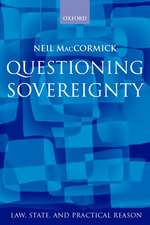Understanding EU Decision-Making
Autor Edward Besten Limba Engleză Hardback – 12 feb 2016
| Toate formatele și edițiile | Preț | Express |
|---|---|---|
| Paperback (1) | 446.65 lei 6-8 săpt. | |
| Springer International Publishing – 30 mar 2018 | 446.65 lei 6-8 săpt. | |
| Hardback (1) | 583.45 lei 6-8 săpt. | |
| Springer International Publishing – 12 feb 2016 | 583.45 lei 6-8 săpt. |
Preț: 583.45 lei
Preț vechi: 686.42 lei
-15% Nou
Puncte Express: 875
Preț estimativ în valută:
111.66€ • 116.27$ • 94.37£
111.66€ • 116.27$ • 94.37£
Carte tipărită la comandă
Livrare economică 11-25 martie
Preluare comenzi: 021 569.72.76
Specificații
ISBN-13: 9783319223735
ISBN-10: 3319223739
Pagini: 140
Ilustrații: XXI, 136 p. 31 illus., 24 illus. in color.
Dimensiuni: 155 x 235 x 15 mm
Greutate: 0.4 kg
Ediția:1st ed. 2016
Editura: Springer International Publishing
Colecția Springer
Locul publicării:Cham, Switzerland
ISBN-10: 3319223739
Pagini: 140
Ilustrații: XXI, 136 p. 31 illus., 24 illus. in color.
Dimensiuni: 155 x 235 x 15 mm
Greutate: 0.4 kg
Ediția:1st ed. 2016
Editura: Springer International Publishing
Colecția Springer
Locul publicării:Cham, Switzerland
Public țintă
Professional/practitionerCuprins
Introduction.- EU Decision-Making: An Overview of the System.- Why Do We Have the EU Institutions?_ Legislative Procedures.- Delegated and Implementing Acts.- Making the Internal Market Work: The EU and Other Actors.- Economic Governance.- Foreign and Security Policy.- Conclusions.- Annex.- Index.
Notă biografică
Edward Best (1958) is Head of Unit at the European Institute of Public Administration (EIPA), Maastricht, and honorary Senior Fellow of Maastricht University. He specializes in European institutions and the political aspects of European integration as well as comparative regionalism and the management of regional organizations. He has been responsible for successive framework contracts to provide training services to the EU institutions on European governance, and has given regular courses in the European Commission and EU Agencies. He is the author of EU Law-Making in Principle and Practice (Routledge, 2014). He is co-editor of The Institutions of the Enlarged European Union (Edward Elgar, 2008) with Thomas Christiansen and Pierpaolo Settembri, and of Rethinking the European Union: IGC 2000 and Beyond (EIPA, 2000) with Mark Gray and Alexander Stubb, and has published numerous articles on the EU and institutional arrangements for regional integration.
Textul de pe ultima copertă
This book presents in a concise and accessible way why the EU institutional system exists in its present form, how the EU fits into the world as a system of governance, and who is involved in EU policy processes. It outlines the historical context which has shaped the EU system, gives a summary of the system's basic principles and structures, and describes its actors, procedures and instruments. The main theme is to show that EU decision-making is not just a matter of action at some higher and separate level, of ‘them and us’, but rather that it involves different forms of cooperation between European, national and regional authorities, as well as interaction between public and private actors. Numerous short case studies illustrate how people’s day-to-day activities are affected by EU decisions, and how individuals’ concerns are represented in the decision-making process. The book provides insights and examples which will be very helpful for all students of European integration. It will also be a valuable resource for European citizens wishing to understand the basic realities and rationales, as well as some of the dilemmas, behind EU policy-making.
Caracteristici
Explains the main decision-making processes of the EU Provides objective background for understanding why the EU works as it does Illustrates how people’s day-to-day activities are affected by EU decisions Brings the EU alive for students and non-specialist audiences as well as EU practitioners




















